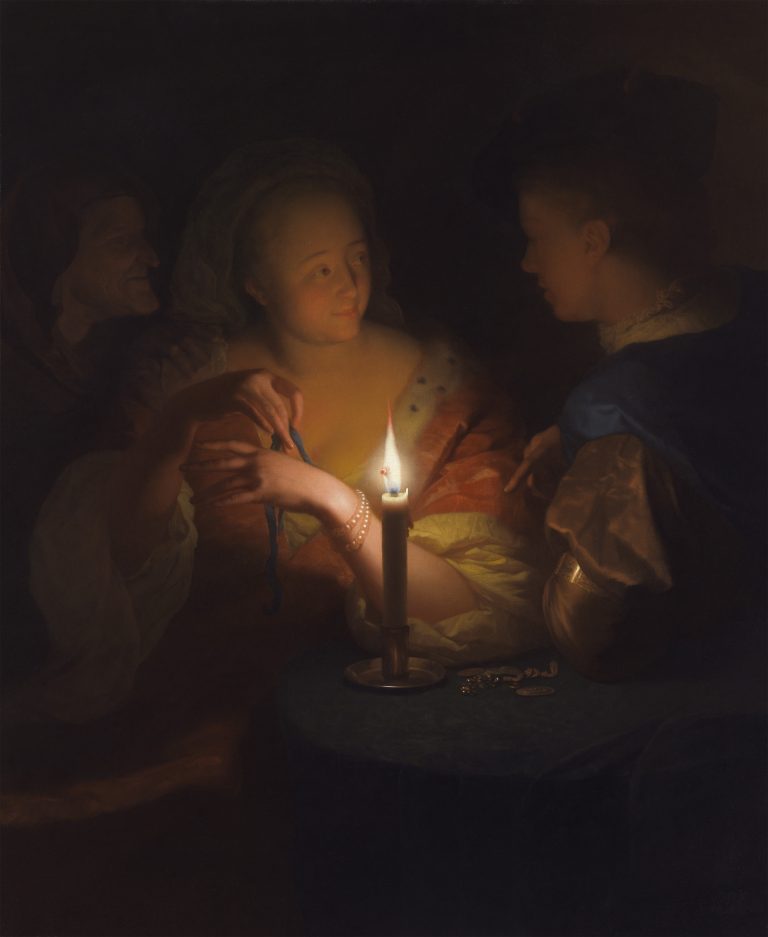By the light of a single candle, we see a young woman holding a blue ribbon in her right hand. Her rather revealing dressing gown of orange and yellow satin trimmed with ermine, and her double pearl bracelet suggest her comfortable circumstances. She looks at a young man who is rendered in lost profile, his gesturing hand indicating that they are deep in conversation. In this darkened interior, one can barely make out the young man’s notched beret and the elegant red-brown garment he wears over a white shirt trimmed with lace at the neck. He also wears a blue shawl and a gold-colored armband above his left elbow. Barely visible at the left is an old woman, seen in profile. She has placed her left hand on the young woman’s shoulder while simultaneously holding the veil draped over the girl’s hair, having pulled it back to reveal the young woman’s beautiful face.
The candle is situated on a table covered with a dark green cloth, and lying next to the simple brass candleholder are gold coins and a string of jewels. Considering the expensive items on the table, one can only assume that the picture depicts a young man visiting a woman of easy virtue, a reading that is corroborated by the presence of the old procuress standing behind her. Godefridus Schalcken made deliberate use of his specialty—the illumination of a setting with the light of a burning candle—to accentuate the intimacy and sexual innuendo of the scene. This setting immediately defines the encounter as one that cannot take place by the light of day, as something furtive and immoral. Schalcken painted a large number of erotic scenes, which is remarkable considering that he came from a prominent Dordrecht family of rather dogmatic clergymen and theologians who certainly would have frowned on such themes. Nevertheless, the good family relations, to which the archival documentation testifies, were in no way spoiled by the artist’s choice of subject matter.
Bearing in mind Schalcken’s background, it is probable that this brothel scene portrays the Prodigal Son squandering his inheritance “with riotous living” (Luke 15:13). An additional important clue is the old-fashioned notched beret worn by the young man, which immediately calls to mind Caravaggesque interpretations of this New Testament parable that were produced from the 1620s to the 1640s by Utrecht artists such as Jan van Bijlert (1597/98–1671) and especially Gerrit van Honthorst (1592–1656).1 In Van Honthorst’s paintings, moreover, candlelight often plays an important role, and Schalcken doubtless took note of his manner of portrayal. An interesting example is Van Honthorst’s Merry Company of 1622 in Munich, a painting first documented in 1719 in Düsseldorf in the collection of Johann Wilhelm, Elector Palatine, as “The Prodigal Son in the brothel, succumbing to the temptations of drinking and caressing.” 2
A later, thematically related composition by Van Honthorst, The Procuress, is preserved in Utrecht (fig 1). On this panel of 1625 we see, just as in Schalcken’s painting, three figures at a table on which stands a lighted candle partly concealed by the young man (whether or not identifiable as the Prodigal Son).3 The depictions of the procuress in these two paintings are strikingly similar.4 By highlighting the low neckline of the strumpet’s dress, her lute, and the feathers adorning her hair, however, Van Honthorst leaves no doubt about her dishonorable profession. Schalcken, by contrast, portrayed his young lady with greater subtlety, even though his contemporaries would have had no trouble understanding what his painting depicted. Schalcken’s wealthy international clientele undoubtedly preferred his sophisticated and veiled interpretation of a visit to a courtesan over Van Honthorst’s more plebeian portrayal of the same subject.
Lovers was long part of one of England’s most important private collections: the Cook Collection at Doughty House, Richmond. This collection was formed by Sir Francis Cook (1817–1901) with the help of Sir John Charles Robinson (1824–1913). The years from 1868 to 1876 were particularly rich in acquisitions; indeed, in the latter year Sir Francis had no fewer than 510 paintings in his possession.5 Schalcken’s work, too, probably entered his collection in that period, when the artist’s reputation was particularly strong.6 In 1880 Schalcken’s fame as a candlelight painter was given an additional boost in England by the publication of a widely read ghost story about the Dordrecht artist written by Sheridan La Fenu (1814–73).7 Cook even acquired a second painting by Schalcken, a self-portrait of the artist holding his palette and brushes by candlelight (fig 2).8 This painting, dated 1695, originated during Schalcken’s stay in London.9 It is possible to date Lovers to the same period, 1692–96, but its origin in the painter’s last period, when he was living in The Hague, cannot be ruled out. At any rate, its execution on a rather large canvas, its light palette, the uniform and thin application of paint, and the woman’s trappings and her high forehead clearly show that the picture originated some time between 1692 and 1706.
